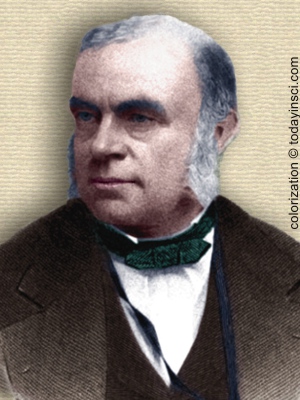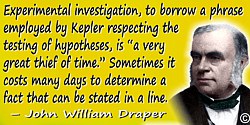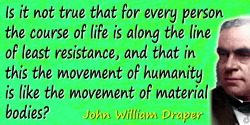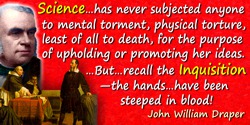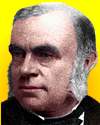 (source)
(source)
|
John William Draper
(5 May 1811 - 4 Jan 1882)
English-American chemist who pioneered in photochemistry.
|
John William Draper.
Preface to Scientific Memoirs (1878)
[p.ix] During the past forty years I have devoted much time to the experimental investigation of scientific topics, and have published the results in various journals, pamphlets, and the transactions of learned societies. They have been largely disseminated in European languages, and many of the conclusions they have presented have been admitted into the accepted body of scientific knowledge. …
…[S]ince they are too voluminous to be published in full … [I here discuss] only such as are connected with the effects of Radiations or of Radiant energy, these having been distinguished by the American Academy of Science, as manifested by its award to me of the Rumford medal for discoveries in light and heat.
Among many other subjects treated of in these pages, the reader will find an investigation of the temperature at which bodies become red-hot, the nature of the light they emit at different degrees, the connection between their condition as to vibration and their heat. It is shown that ignited solids yield a spectrum that is continuous, not interrupted. This has become one of the fundamental facts in astronomical spectroscopy. At the time of the publication of this Memoir, no one in America had given attention to the spectroscope, and, except Fraunhofer, few in Europe. I showed that the fixed lines might be photographed, doubled their number, and found other new ones at the red end of the spectrum. The facts thus discovered I applied in an investigation of the nature of flame and the condition of the sun’s surface. I showed that under certain circumstances rays antagonize each other in their chemical effect, and that the diffraction spectrum has great advantages over the prismatic, which is necessarily distorted. I attempted to ascertain the distribution of heat in the diffraction spectrum, and pointed out that great [p.x] advantages arise if wave-lengths are used in the description of photographic phenomena. I published steel engravings of that spectrum so arranged. I made an investigation of phosphorescence, and obtained phosphorescent pictures of the moon. Up to this time it had been supposed that the great natural phenomenon of the decomposition of carbonic acid by plants was accomplished by the violet rays of light, but by performing that decomposition in the spectrum itself, I showed that it is effected by the yellow. Under very favorable circumstances, I examined the experiments said to prove that light can produce magnetism, and found that they had led to an incorrect conclusion. The first photographic portrait from the life was made by me: the process by which it was obtained is herein described. I also obtained the first photograph of the moon. I made many experiments on and discovered the true explanation of the crystallization of camphor towards the light. When Daguerre’s process was published, I gave it a critical examination, and described the analogies existing between the phenomena of the chemical radiations and those of heat. For the purpose of obtaining more accurate results in these various inquiries, I invented the chlor-hydrogen photometer, and examined the modifications that chlorine undergoes in its allotropic states. Since in such researches more delicate thermometers are required than our ordinary ones, I entered on an investigation of the electro-motive power of heat, and described improved forms of electric thermometers. In these memoirs will be found a description of the method made use of for obtaining photographs of microscopic objects, together with specimens of the results. In a physiological digression respecting interstitial movements of substances, I examined the passage of gases through thin films such as soap-bubbles, and the force with which these movements are accomplished, applying the facts so gathered to an explanation of the circulation of the sap in plants, and of the blood in animals. Returning to an inquiry as to the distribution of heat and of chemical force in the spectrum, I was led to conclude, in opposition to the current opinion, that all the colored spaces are equally warm; and that, so far from one portion — the violet—being distinguished by producing chemical effects, every ray can accomplish special changes. This series of experiments on radiations is concluded in this volume by an examination of the chemical action of burning-lenses and mirrors. …
[p.xi] ... Experimental investigation, to borrow a phrase employed by Kepler respecting the testing of hypotheses, is “a very great thief of time.” Sometimes it costs many days to determine a fact that can be stated in a line. The things related in these memoirs have consumed much more than forty years.
Such a publication, therefore, assumes the character of an autobiography, since it is essentially a daily narrative of the occupations of its author. To a reader imbued with the true spirit of philosophy, even the shortcomings easily detectable in it are not without a charm. From the better horizon he has gained he watches his author, who, like a pioneer, is doubtfully finding his way, here travelling on a track that leads to nothing, then retracing his footsteps, and again, undeterred, making attempts until success crowns his exertions. To explore the path to truth implies many wanderings, many inquiries, many mistakes.
Perhaps, then, since this book is a sort of autobiography, its reader [p.xii] will bear with me if I try to make it more complete by here referring to other scientific or historical works in which I have been engaged.
In early life I had felt a strong desire to devote myself to the experimental study of nature; and, happening to see a glass containing some camphor, portions of which had been caused to condense in very beautiful crystals on the illuminated side, I was induced to read everything I could obtain respecting the chemical and mechanical influences of light, adhesion, and capillary attraction. Experiments I soon made in connection with these topics are described in these memoirs. Some of them I used in a Thesis for the degree of Doctor of Medicine in the University of Pennsylvania. My thoughts were thus directed to physiological studies, and I published papers on these topics in the American Journal of Medical Sciences. The favorable impression they made caused me to be appointed, in 1836, Professor of Chemistry and Physiology in Hampden Sidney College, Virginia, an appointment which enabled me to convert experimental investigation, thus far only an amusement, into the appropriate occupation of my life.
Several of the memoirs contained in this volume were composed at that time. To them I was indebted, without any application on my part, for an appointment to the Professorship of Chemistry and Physiology in the University of New York. Soon afterwards I published a work on the Forces that Produce the Organization of Plants. The lectures on Physiology I gave at that time I improved from year to year, and at length published them as a treatise on Human Physiology. It was very favorably received by the medical profession.
Among new experiments and explorations on physiological subjects contained in that book may be mentioned the selecting action of membranes; cause of the coagulation of blood; theory of the circulation of the blood; explanation of the flow of sap; endosmosis through thin films; measure of the force of endosmosis; respiration of fishes; action of the organic muscle fibres of the lungs; allotropism of living systems; new observations on the action of the skin; functions of nerve vesicles and their electrical analogies; function of the sympathetic nerve; explanation of certain parts of the auditory apparatus, particularly of the cochlea and semicircular canals; the theory of vision; the theory of muscular contraction.
From the study of individual man it is but a step to the consideration of him in his social relation, and this, accordingly, had been done in the second part of my work on Physiology. But the subject being too extensive to be dealt with satisfactorily in that manner, I published the [p.xiii] materials that I had collected in a separate book, under the title of “A History of the Intellectual Development of Europe.” The object of this was mainly to point out that the intellectual progress of nations proceeds in the same course as the intellectual development of the individual; that the movement of both is not fortuitous, but under the dominion of law; that the stages of personal development are paralleled by the stages of social development, and, indeed, as palæontology has proved, by the evolution of all animated nature; that there is an ascent of man through well-marked epochs from the most barbarous to the most highly civilized condition. This book was translated into many languages: in some of them several editions of it were issued. Portions of it relating to Mohammedan science were translated into Arabic.
About this time, circumstances led me to deliver before the New York Historical Society a course of lectures on American topics, considered from a similar point of view. These were enlarged, and published under the title of “Thoughts on the Civil Policy of America.” This, like the preceding, was extensively translated and circulated. The train of investigation on which I had thus entered led me to a far more serious undertaking—a “History of the American Civil War,” which had just then closed. To this, moreover, I was incited by the earnest request of some who had been chief actors in the events, and who very effectively aided me. I had the inestimable advantage of enjoying the friendship of many whose names have now become illustrious in connection with those times. The Secretary of War gave me access to the public documents on both sides, and to him I was indebted for guidance in the description of many of the most important incidents and the course of national policy. To generals who had commanded in great battles and conducted great campaigns I owed information which they alone could impart, and, in like manner, most valuable assistance was given me in special cases by persons eminent in military and civil life. It is often said that the history of any very great social event cannot be correctly written by a contemporaneous author, and that we must wait until passions have subsided and interests ceased for a narrative of the truth. But this is not so. More depends on the impartiality of the writer than on the deadening lapse of time. The best history will always be written by one who has had the best opportunity of getting at the facts, who has had the privilege of the friendship or personal acquaintance of those who have been conspicuous in the events.
No one can consider the intellectual development of Europe without contemplating the forces that have brought that continent to its present social condition—forces that have never ceased to be in active opposition. Under the title of a “History of the Conflict of Religion and Science,” [p.xiv] I endeavored to describe their warfare. This work has passed through a great many editions in America and England. It has been translated into French, Spanish, German, Russian, Italian, Polish, Servian, etc. It finds very many readers in Eastern Europe. And of some of these translations several editions have been issued.
When I thus look back on the objects that have occupied my attention, I recognize how they have been interconnected, each preparing the way for its successor. Is it not true that for every person the course of life is along the line of least resistance, and that in this the movement of humanity is like the movement of material bodies?
To my American reader I need say nothing for the purpose of securing his kind appreciation of this work. I know that he, recognizing the difficulties encountered in such a long series of experiments, will extenuate its imperfections, and regard it as a contribution from this side of the Atlantic to the common fund of human knowledge, and especially to one of its most important departments, at a period when the main subject on which it treats had scarcely attracted scientific attention.
New York, January, 1878.
- Science Quotes by John William Draper.
- 5 May - short biography, births, deaths and events on date of Draper's birth.
